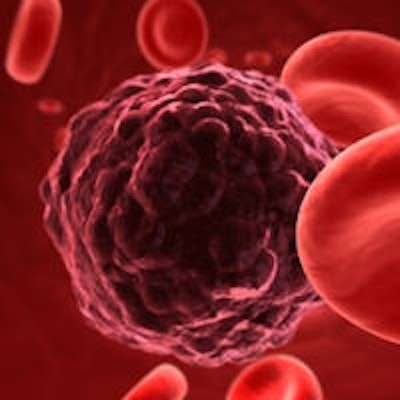
Compared with squamous cell carcinoma (SCC), basaloid squamous cell carcinoma (BSCC) is not an independent adverse prognostic factor for head and neck cancer patients, according to a new study in JAMA Otolaryngology -- Head & Neck Surgery (December 2013, Vol. 139:12, pp. 1306-1311).
BSCC is a rare type of squamous cell carcinoma that may develop in a variety of head and neck areas, including the oropharynx, hypopharynx, and larynx, noted researchers from the Indiana University School of Medicine in Indianapolis. About 2% of all head and neck SCCs and 5% of all node-positive SCCs are classified as BSCCs. Compared with SCC, patients with head and neck BSCC more often have cervical lymph node involvement and distant metastasis.
Like squamous cell carcinoma, BSCC is associated with alcohol and tobacco use, and is often seen in men who are in their 60s and 70s. Since first being described in1986, BSCC has often been considered to show more aggressive behavior and have a poorer prognosis than SCC.
However, recent investigations have shown an association between the human papillomavirus (HPV) and BSCC, particularly HPV type 16. It has also been suggested that BSCC may be a heterogeneous entity, with the subset of BSCC associated with HPV having a more favorable prognosis than those that are not, according to the study authors.
“Our data do not support altering current standards of care for treating patients with head and neck cancer based purely on the BSCC.”
Although several reports suggest that patients with BSCC more often have advanced-stage disease, it is not yet clear if BSCC is an independent prognostic factor after accounting for multiple other variables that influence clinical outcomes in head and neck cancer, the researchers noted.
Their study used a large population-based registry to explore the effect of BSCC on overall survival in head and neck cancer. Using the Surveillance, Epidemiology, and End Results Program of the National Cancer Institute, the researchers analyzed case data for 34,196 patients treated between January 2004 and December 2009 with head and neck primary SCC and BSCC of the oral cavity, oropharynx, larynx, or hypopharynx.
These included 12,493 patients with disease in the oral cavity, 13,908 with disease in the oropharynx, and 7,795 patients with disease in either the larynx or the hypopharynx.
Oral cavity analysis
Of the 12,493 patients with disease in the oral cavity, 12,417 had SCC and 76 had BSCC. Compared with those with SCC, a higher proportion of patients with BSCC were black (14.7% versus 6.0%), male (73.7% versus 61.7%), had high-grade tumors (75.0% versus 17.2%), had stage IV tumors (36.8% versus 23.8%), and had a lymph node dissection (59.2% versus 44.4%).
The three-year overall survival for those with SCC was 62.3% versus 53.9% for BSCC, the study found.
Oropharynx analysis
Of the 13,908 patients with disease in the oropharynx, 13,422 had SCC and 486 had BSCC. Compared with those with SCC, a higher proportion of patients with BSCC had high-grade tumors (90.9% versus 47.0%) and a lymph node dissection (39.3% versus 33.1%). A smaller proportion of patients with BSCC had T3 or T4 disease (24.7% versus 30.9%), and the mean tumor size for BSCC was slightly smaller than for SCC (2.7 cm versus 3.0 cm).
The three-year overall survival was 79.8% for patients with BSCC and 65.1% for those with SCC, the study found.
Larynx and hypopharynx analysis
Of the 7,795 patients with disease in either the larynx or hypopharynx, 7,715 had SCC and 80 had BSCC. Compared with those with SCC, a higher proportion of patients with BSCC had disease in the hypopharynx (70.0% versus 27.0%), a high-grade tumor (82.0% versus 21.3%), stage IV disease (50.0% versus 25.6%), T3 or T4 disease (36.3% versus 28.4%), a lymph node dissection (31.3% versus 12.0%), and a prior cancer diagnosis (35.0% versus 16.9%). A larger proportion of patients with BSCC had nodal disease (51.3% versus 25.6%), and fewer received postoperative radiation therapy (22.8% versus 31.3%).
The three-year overall survival was 58.1% for patients with BSCC and 67.0% for those with SCC, the study found.
Results
Patients with BSCC had higher grade tumors and were more often treated with lymph node dissection, the researchers noted.
"In the oral cavity and the larynx and hypopharynx, patients with BSCC did not have a statistically significantly higher hazard ratio for death compared with those with SCC," the researchers wrote. "Indeed, in the oropharynx, patients with BSCC had a statistically significantly lower hazard ratio for death than did those with SCC. The association between HPV and BSCC in the oropharynx likely explains the relatively favorable outcomes for these patients."
The incidence of HPV-associated tumors appears to be increasing, potentially due to increased recognition of the entity or to changing demographics and sexual practices, the researchers noted. Since HPV seems to be associated with at least a subset of BSCC, it may be that the prognostic significance of BSCC is changing.
Older patients with BSCC may represent a more unfavorable population of tumors less commonly driven by HPV compared with the study's patient population from January 2004 through December 2009, which includes an era of increasing HPV prevalence, the researchers pointed out.
Conclusion
"While some have advocated for more aggressive clinical treatment of patients with BSCC, including the suggestion of mandatory neck dissections and postoperative chemoradiation in all patients, our data do not support altering current standards of care for treating patients with head and neck cancer based purely on the BSCC," the researchers concluded.
Despite the study's limitations, the findings suggest no indication of a poorer prognosis for patients who have BSCC compared with those who have SCC, the researchers added.
After controlling for multiple patient, disease, and treatment characteristics, patients with BSCC had no statistically significant difference in the hazard ratio for death compared with patients with SCC in the oral cavity, larynx, and hypopharynx, and had a statistically significantly lower hazard ratio for death in the oropharynx, they wrote.
The findings suggest that BSCC histology is not an independent adverse prognostic factor in head and neck cancer, the researchers concluded.



















